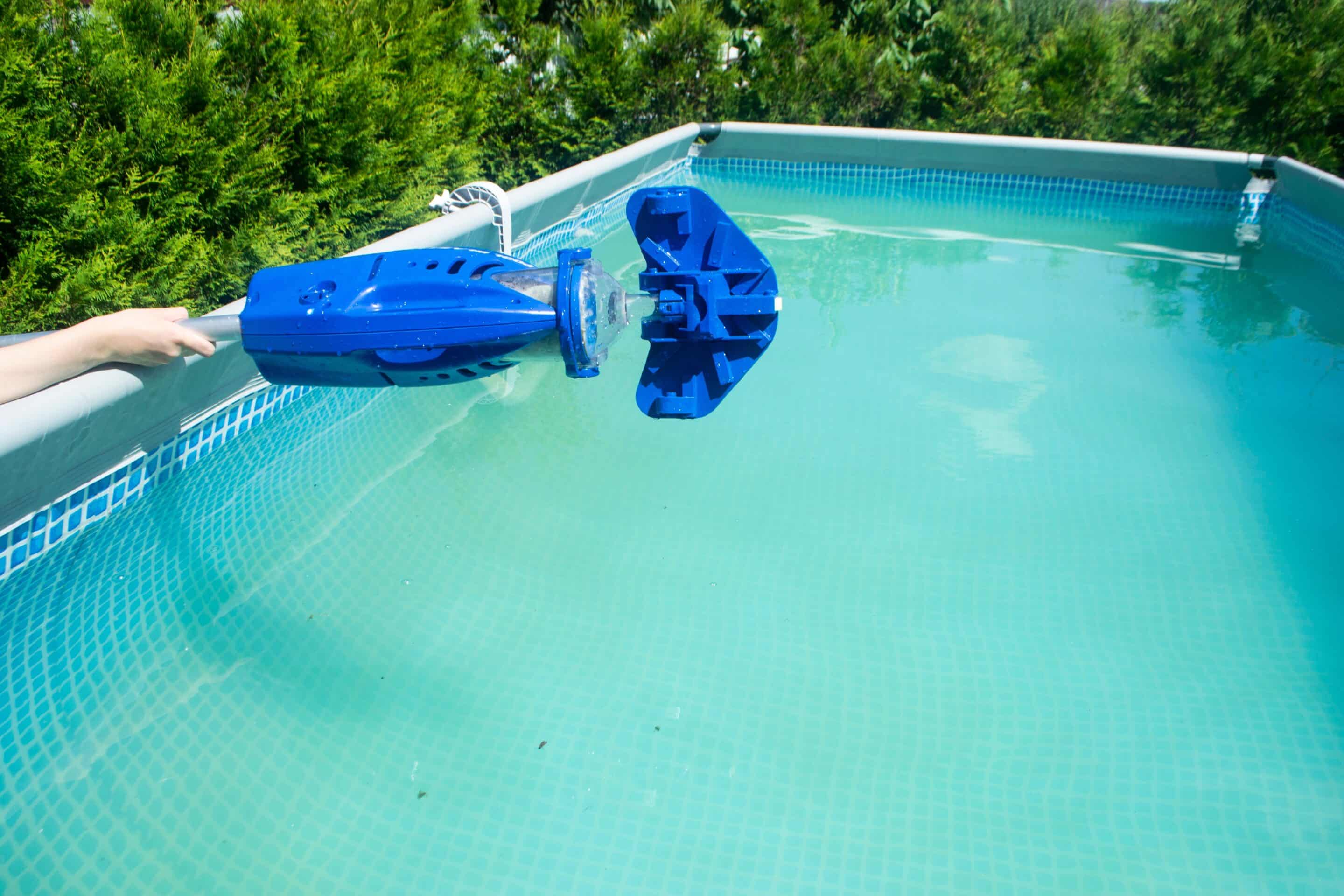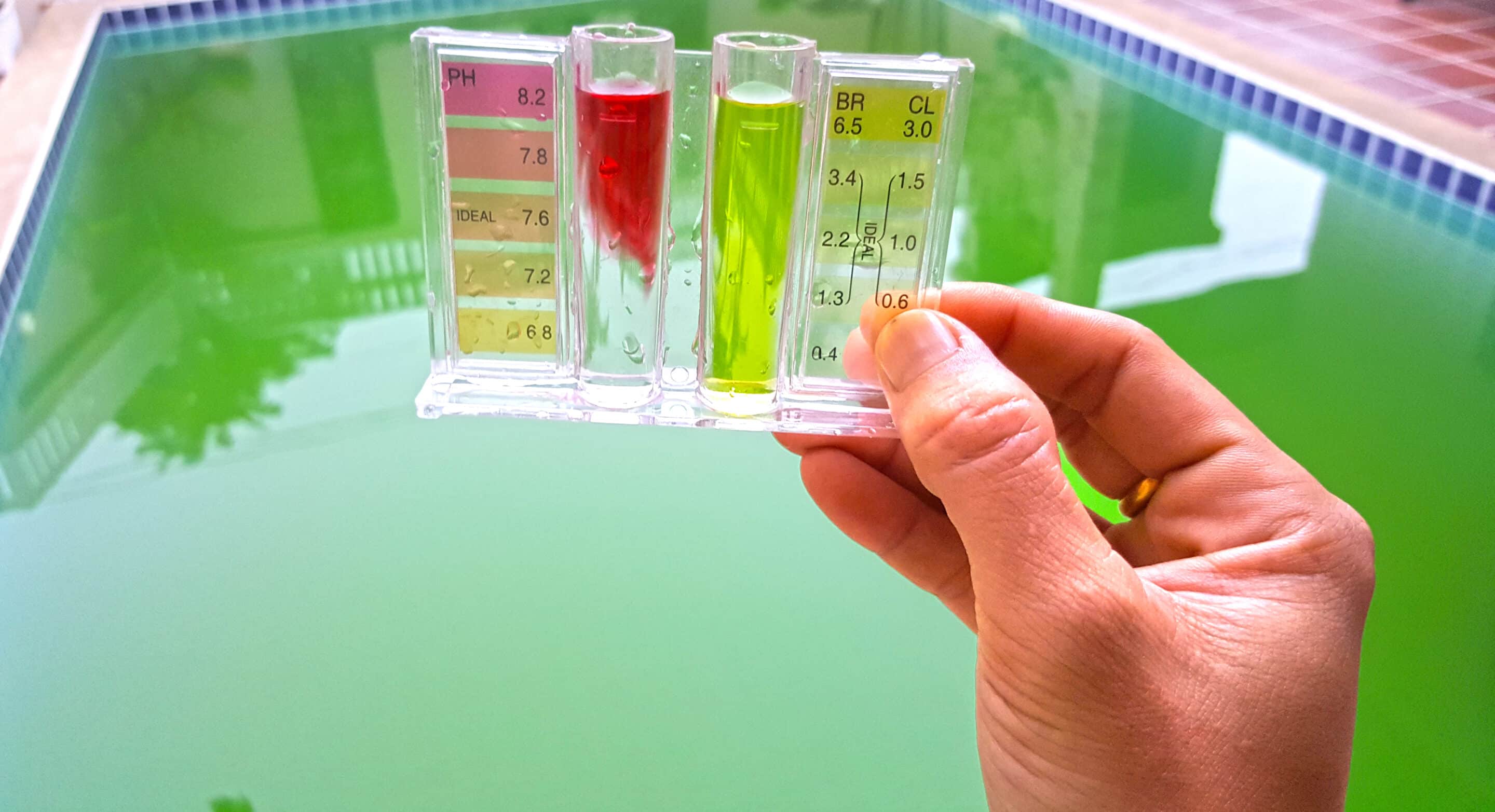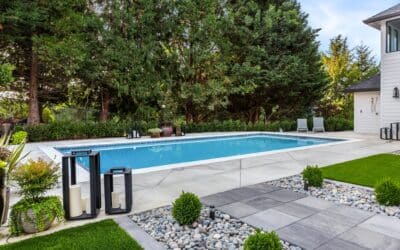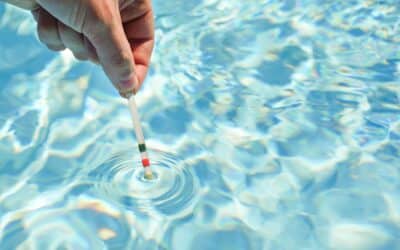There is nothing more refreshing than a dive in a backyard pool under the scorching sun. As the temperature in Ottawa breaks double digits, it’s time to plan for summer and think about opening your pool. One thing that every pool opening process has in common is getting the water clean and ready for swimming. If you aren’t sure how to remove algae or cloudiness from your pool, don’t despair. At Benson Pools, we can lend a hand with this quick and practical guide.
What Causes Pool Algae?
Algae are photosynthetic organisms that use the combination of the sun, water, and carbon dioxide to produce their food. Clinging to walls, floor, and steps of a pool or simply floating in the water, algae can grow quickly, ruining the clarity of your pool water and becoming home to potentially harmful bacteria like parasites, E. coli and salmonella.
Pool algae are typically caused by out-of-balance water, low or inconsistent chlorine levels, or poor water filtration or circulation. Although multiple colours of algae exist, the most common types are dark green, green, blue-green, or yellowish green, causing the pool water to turn the corresponding colour.
Identifying the Type of Algae in Your Pool
It is fairly easy to identify the type of algae in the pool because different kinds of algae have various colours. Each type also has unique attributes:
- Green algae in the pool can either float in the water or cling to the walls. Green algae can be killed by brushing the pool, shocking, or adding Algaecide 60.
- Mustard or yellow algae looks similar to sand at the bottom of the pool. It can be killed by aggressively brushing the bottom of the pool and adding Algaecide 60.
- Black algae feels slimy and looks like tiny black spots. It can also be killed with aggressive brushing and adding Algaecide 60.
- Pink slime and white water mould are not true algae but are often mistaken for them. These thrive in similar conditions and can be eliminated by brushing all pool surfaces, shocking the pool, and adding Algaecide 60.
What Causes Pool Cloudiness?
Pool cloudiness can be caused by one of the following pool issues:
- Poor water filtration. Filter problems are the leading cause of cloudy pools, as inadequate filtration systems fail to remove tiny contaminants from the water.
- Low chlorine levels. When there is not enough chlorine in the pool to sanitize the water, bacteria, pathogens, and cloudy water may form.
- Poor water chemistry. High levels of pH, calcium hardness, and total alkalinity can form scale on your pool surfaces and inside plumbing, leading to poor filtration and cloudy water.
- Early algae growth. At the early stages of algae growth, before turning green, pool water may appear cloudy instead.
How Do Weather and Usage Impact Pool Water Quality?
Pool water quality can be significantly impacted by weather and usage patterns, with external conditions promoting algae growth, cloudiness, and scum formation.
- Rainstorms. Precipitation can dilute chlorine levels, alter the pH balance, and introduce contaminants such as dirt, pollen, and debris. If not addressed promptly, this can cause the water to become cloudy and create ideal conditions for algae to thrive.
- Heatwaves. Algae thrive in warm water. Heatwaves can accelerate algae growth by increasing water temperature and speeding up chemical reactions. Note that warmer water also requires more chlorine to achieve its sanitizing effect.
- Usage patterns. Heavy usage during events like pool parties introduces sunscreen, body oils, sweat, and cosmetics to the water, potentially contaminating it. This can lead to cloudy water or additional scum buildup.
- Chlorine loss. Chlorine breaks down faster during the day due to the direct UV exposure. This means that chlorine levels can drop significantly over a sunny day; adjusting dosing schedules or using a stabilizer can help maintain their effectiveness.
How to Remove Algae from a Pool
The good news is that pool algae and cloudy pool water can be addressed in a matter of days. To quickly get rid of algae and turn green pool water blue again, follow these steps:
- Test the pool water to determine chlorine levels and the pH.
- Use a pool brush to clean the walls, floor, and stairs of the pool from any algae.
- Shock the pool with a high dose of chlorine.
- Add algaecide to kill any remaining algae.
- Run the pool filter non-stop for 24 to 48 hours.
- Vacuum the pool to remove any remaining dead algae.
- Retest water chemistry and adjust as needed.
How to Deal With Pool Cloudiness

If you notice your once-clear pool water turning cloudy, follow these steps to restore the clarity:
- Check the pool water chemistry, including pH, alkalinity, and calcium levels.
- Run the pool filter continuously to remove any particles.
- Use a dedicated pool clarifier to coagulate the water.
- Vacuum the pool to remove any settled debris.
- Clean the pool filter to ensure optimal filtration.
- Shock the pool with a high level of chlorine to kill any algae or bacteria that may be causing cloudiness.
Common Mistakes to Avoid When Treating Algae or Cloudiness
When attempting to tackle algae or cloudy water on their own, many pool owners find that the problem persists. If past treatments haven’t worked, know that you are not alone. Some common mistakes that cause the issue recurrence include:
- Not brushing before shocking. Pool walls and floor must be brushed before shocking. Otherwise, algae can cling to surfaces and survive treatment.
- Using the wrong kind of shock or clarifier. Using the wrong type of product can worsen the problem and leave undesired residue behind.
- Not running the filter long enough. After adding clarifier or shocking, the filtration system needs to run non-stop for at least 24 to 48 hours to clear out the dead algae and other particles.
- Failing to clean the filter afterward. If you forget to clean the filter after treatment, leftover contaminants and dead algae will just circulate back into the pool.
Ongoing Maintenance for a Clear Pool
Keeping your pool algae- and cloudiness-free requires regular maintenance. Here are a few simple steps you can take to keep your pool water fresh and clear at all times:
- Check the water balance on a consistent basis;
- Clean the pump, filter, and skimmer regularly;
- Use an algaecide regularly to prevent algae growth;
- Ensure that the water filtration system is operating properly to circulate the water throughout the pool;
- Brush your pool regularly, including the walls, steps, and floor;
- Shock the pool weekly with concentrated forms of chlorine;
- Vacuum the pool on a regular basis.
Choosing the Right Pool Chemicals: What to Look For

Clearing a cloudy swimming pool, or one full of algae, is all about choosing the right products for the job. At Benson Pools, we use only high-quality, tested products, tailored to your pool’s contaminants and water chemistry levels. Common pool chemicals include:
- Clarifiers and flocculants. Clarifiers bind small particles into larger ones that are easier to filter out, while flocculants sink debris to the bottom, allowing it to be vacuumed out. Clarifiers are ideal for ongoing maintenance, while flocculants are better for severe cloudiness.
- Liquid and granular shock. Liquid chlorine works quickly and is easy to apply, while granular chlorine shock is convenient for storage and can offer a more concentrated treatment.
- pH balancers and test kits. You must always test your water before adding chemicals – pH balancers and reliable test kits will help you achieve the right balance.
- Preventive algaecides and kill-treatments. Preventive algaecides are great for weekly maintenance, while kill-treatments are more potent formulas used to eliminate active algae blooms.
Hiring A Professional
If the task of how to remove algae or cloudiness from your pool still seems daunting, know that you are not alone. Many pool owners find algae and cloudiness a tough problem to deal with, as the issues could be caused by a number of things, from simple lack of chlorine to more advanced filtration issues. The good news is that you can always rely on professional help from Benson Pools. Reach out to us today to schedule your pool opening procedure or book ongoing maintenance visits.


